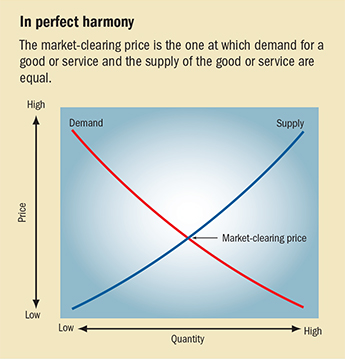Back to Basics
What Is a Price?
Finance & Development, December 2013, Vol. 50, No. 4
Maybe more than one bargained for. The answer varies depending on the transaction
At its most basic, a price is the amount of money that a buyer gives to a seller in exchange for a good or a service. When someone hands over $2.00 and receives a pound of tomatoes, the price is straightforward observation: $2.00 a pound. When an actual, observable transaction takes place, the price is sometimes called the traded price or the spot price.
But there are many other types of price. Some of them, such as the marginal price, are conceptual. Others are related to the timing of a potential transaction or to the relative power of the buyer and the seller. All of them, however, ultimately have some relation to the spot price.
Suppose that the tomato transaction takes a slightly different form. The seller might indicate a willingness to sell the tomatoes at a certain price, called the selling price or the ask price. The buyer may make it known that he is willing to pay a different price, which is called the bid price. Such a transaction can occur only if the seller values the tomatoes at $2.00 a pound or less, and the buyer values the tomatoes at $2.00 a pound or more. That is, the bid price must be at least as high as the ask price. If it is not, one or both of the parties would be better off keeping what they already had, whether it is tomatoes or money.

Clearing the market

Most of the time, when economists speak of price, they are referring to a market-clearing price—that is, the price at which the amount of a good or service supplied by all sellers in a market is equal to the amount demanded by all buyers. Generally, economists assume that demand decreases as prices rise, and supply increases with price. The point at which these two prices are the same, or intersect, is the market-clearing price (see chart). If a farmer raised prices to a level greater than the market-clearing price on tomatoes, she would not sell them all, and if she lowered prices, she would have to turn away customers because she would run out of tomatoes before the buyers ran out of demand.
But market-clearing prices are not set in stone. Supply and demand can change. For example, if all customers suddenly decided they liked tomatoes more than they used to and were willing to pay a higher price for the same amount, the market-clearing price would rise. It could also rise if the supply of tomatoes declined—because of, say, planting decisions or the weather. The clearing price could also decline with changes in demand or supply.
Many prices
The above examples assume a single price that everyone is charged for the same good or service. But in reality many different prices can exist in a market at the same time, depending on the conditions under which a sale takes place.
Suppose the local supermarket has a lot of tomatoes that are likely to go bad in a few days. The market’s managers decide to reduce the price to attract buyers and move more tomatoes. One pound of tomatoes is still $2.00, but if a buyer takes two pounds the cost is $3.00. There is a difference between a marginal price—the cost of an additional unit of a good, in this case a pound of tomatoes—and the average price. If a buyer takes two pounds, the average price is $1.50 pound. But the marginal price is $2 for the first pound and $1 for the second.
Prices can also differ depending on when the actual transaction takes place and under what conditions. For example, suppose a customer wants to buy 10 pounds of tomatoes and pick them up the next day. The price for a transaction scheduled for the future is called a forward price. The farmer may be happy to set aside those 10 pounds for the customer. Or she may worry that the customer will forget, leaving her with unsold tomatoes. She may ask for payment in advance or perhaps for a partial payment as a deposit. If the customer pays in advance, he runs the risk that the farmer will forget to set aside the tomatoes, leaving him scrambling to find tomatoes. Once again, the price will depend on the relative values the farmer and the customer place on those tomatoes.
Paying for certainty
If the customer values the certainty of getting those tomatoes, he will be willing to pay a higher price. For example, the tomatoes could be for a birthday dinner for someone who loves tomatoes. But if the tomatoes are for a tomato-tossing game at a picnic, the customer could use water balloons or eggs instead.
Suppose the farmer has enormous fields, and 10 pounds of tomatoes represents a small amount of her daily sales. The value she places on knowing the customer will show up is relatively low. Moreover, there is little risk that she will run out of tomatoes before the customer shows up. Whether the customer buys from her does not matter to her pricing decision, and the customer’s forward price should be the same as the expected spot price the next day. If that is the case, the customer might not even bother to settle on a forward price with the farmer. When the seller has the power to set prices and the buyer cannot bargain, the seller is said to be a price setter, and the buyer is said to be a price taker.
If, however, 10 pounds represents half the farmer’s daily sales of tomatoes, the value the customer places on those tomatoes matters a great deal. If the customer wants them for his sister’s birthday, he may be willing to pay a higher forward price, which the farmer will be willing to accept. If the customer does not care that much about the tomatoes, he may not be willing to pay enough to secure the supply. When there are many farmers from whom to buy, no individual seller is able to set the price; the sellers are said to be price takers.
When there are many buyers and many sellers, a single market-clearing price is most likely to prevail for everyone.
A final type of price relates to future options. One can buy the right to transact at a prespecified price in the future, paying what is called an option price. The prespecified price at which one exercises an option is called the strike price. This is the price that comes into play when there is a great deal of uncertainty about how the spot price might change.
Consider again the case of tomatoes, for example. They need hot, dry weather to ripen properly. If the weather is like that in the near future, tomatoes will be abundant, and their price should be relatively low. If, however, rain is forecast for the near future, buyers and sellers would anticipate fewer tomatoes will be ready for harvest, and the price should rise (assuming the same demand). In the latter case, the customer may be willing to pay a small amount now (the option price) to secure the right to buy 10 pounds in the future at a prespecified price (the strike price). If the spot price is higher than the strike price, the customer can exercise the option and buy the tomatoes at the strike price. If the spot price is lower, the customer pays the spot price and saves some money. The option price thus has to be both low enough to induce the customer to pay for the certainty and high enough to compensate the seller for honoring the strike price if it is lower than the spot price.
Values and prices
Because so many factors can influence a price, many people try to work out what a good price might be before testing a market. For example, suppose an engineer has invented a machine for picking tomatoes and she sets up a company to make them. She needs funds to build the machines, so she will try to sell stock in her company to raise the money. If she sets a price too high, some of the shares will be left unsold and she may not raise enough money. If she sets a price too low, a lucky buyer will turn around and sell to someone for a higher price. She has to carefully match the value with the price. What factors should she consider when setting the price
Again supply and demand come into play. How many machines can the new factory produce in a year? At what price will they be sold? How many machines will tomato farmers buy? This will depend on the price of tomatoes, the price of wages paid to tomato pickers, and the price of borrowing the money to buy the machine. All these prices must be ascertained before the engineer can figure out the market-clearing price for her machines—which will determine the price of the stock in her company. The stock price will also depend on how investors expect the company to do in the future. Investors might believe she will be able to make a bean-picking machine next year. If one of the prices underlying the inventions moves—because of a bad harvest, or because bean farms start paying higher wages, or because a competitor invents a bean picking machine next year—the company’s stock price will move too.
There are many types of prices, representing many types of transactions. Each price represents a bargain struck between a buyer and a seller. The motivations of each party, and the prices that arise, can be as unpredictable as the weather and change as quickly. ■


